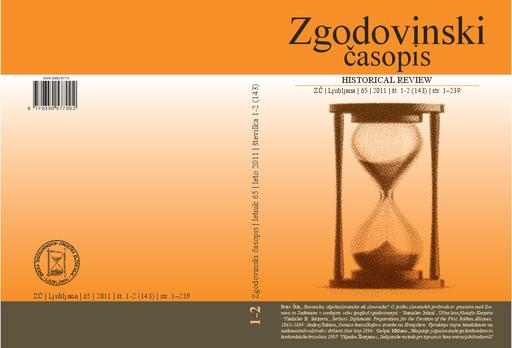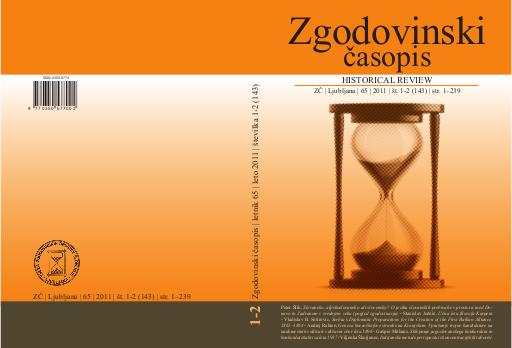/
Serijske publikacije
/
Zgodovinski časopis
Slovansko, alpskoslovansko ali slovensko?
O jeziku slovanskih prebivalcev prostora med Donavo in Jadranom v srednjem veku (pogled zgodovinarja)

Avtor(ji):Peter Štih
Soavtor(ji):Peter Štih (odg. ur.), Dušan Mlacović (ur.), Bojan Balkovec (teh. ur.), Nives Sulič Dular (prev.), Neva Makuc (prev.), Stanislav Južnič (prev.)
Leto:2011
Založnik(i):Zveza zgodovinskih društev Slovenije, Ljubljana
Jezik(i):slovenščina
Vrst(e) gradiva:besedilo
Ključne besede:srednji vek, alpsko-jadranski prostor, jezikovna identiteta slovanskih prebivalcev, Middle Ages, territory between the Alps and the Adriatic, language identity of the Slavic population
Avtorske pravice:

To delo avtorja Peter Štih je ponujeno pod Creative Commons Priznanje avtorstva-Nekomercialno-Deljenje pod enakimi pogoji 4.0 Mednarodna
Datoteke (1)

Ime:ZC_2011_1-2.pdf
Velikost:5.59MB
Format:application/pdf
Stalna povezava:https://hdl.handle.net/11686/file18352
Opis
Razprava najprej ugotavlja, da je moderno razumevanje
srednjeveških jezikovnih oz. govornih
praks odločilno zaznamovalo 19. stoletje, ko
se je z nacionalizacijo zgodovine zgodila tudi
nacionalizacija jezika. Obstoj modernih jezikov
je bil podaljšan daleč nazaj v zgodovino in v
tem smislu se je npr. izraz lingua Sclavanisca,
če se je nanašal na vzhodnoalpski prostor,
razumelo
kot slovenski jezik, čeprav ni takšno
razumevanje pri sodobnikih nikoli izpričano. V
njihovem predstavnem svetu je obstajal samo
en, slovanski jezik, ki je bil skupen različnim
slovanskim ljudstvom.
Metapodatki (12)
- identifikatorhttps://hdl.handle.net/11686/35008
- naslov
- Slovansko, alpskoslovansko ali slovensko?
- O jeziku slovanskih prebivalcev prostora med Donavo in Jadranom v srednjem veku (pogled zgodovinarja)
- Slavic, Alpine Slavic, or Slovene?
- A Historian’s Perspective on the Language of the Medieval Slavic Population Living in the Area between the Danube and the Adriatic
- ustvarjalec
- Peter Štih
- soavtor
- Peter Štih (odg. ur.)
- Dušan Mlacović (ur.)
- Bojan Balkovec (teh. ur.)
- Nives Sulič Dular (prev.)
- Neva Makuc (prev.)
- Stanislav Južnič (prev.)
- predmet
- srednji vek
- alpsko-jadranski prostor
- jezikovna identiteta slovanskih prebivalcev
- Middle Ages
- territory between the Alps and the Adriatic
- language identity of the Slavic population
- opis
- Razprava najprej ugotavlja, da je moderno razumevanje srednjeveških jezikovnih oz. govornih praks odločilno zaznamovalo 19. stoletje, ko se je z nacionalizacijo zgodovine zgodila tudi nacionalizacija jezika. Obstoj modernih jezikov je bil podaljšan daleč nazaj v zgodovino in v tem smislu se je npr. izraz lingua Sclavanisca, če se je nanašal na vzhodnoalpski prostor, razumelo kot slovenski jezik, čeprav ni takšno razumevanje pri sodobnikih nikoli izpričano. V njihovem predstavnem svetu je obstajal samo en, slovanski jezik, ki je bil skupen različnim slovanskim ljudstvom.
- The modern understanding of medieval language practices had a critical impact upon the 19th century, which was the period in which the nationalization of history brought about the nationalization of language as well. As a result, the existence of modern languages was suddenly extended far into the past. The term lingua Sclavanisca was thus perceived as denoting the Slovene language if it referred to the territory of East Alps although no sources have confirmed that the people living in that period perceived it as such. Medieval East Slavs had the concept of but one, namely Slavic, language that was common to a number of Slavic peoples.
- Ideas and theses on the subject dealt with in this article were first presented in a paper titled Slawisch, Alpenslawisch oder Slowenisch zwischen Donau und Adria im Frühmittelalter that was presented at the international conference Sprache und Identität. Taking place in Vienna between January 15 and 17, 2009, the conference was organized by the Institut für Mittelalterforschung of the Österreichische Akademie der Wissenschaften. As a shorter version of the afore-mentioned paper yet much more extensive than this summary, the study will be published in German in the Forschungen zur Geschichte des Mittelalters series published by the Institute. The first part of the treatise looks at the causes for the modern perception of old language practices. Most of such perceptions originated in the 19th century and were largely influenced by the rapidly growing nationalistic movement that perceived the language as one of the central concepts of the national discourse. Scholars of that time firmly believed that the language and the nation (people) were congruent concepts, and therefore each nation (people) spoke its own distinctive language. Slovenes are among the modern European nations in which the correlation between the nation and national identity is particularly pronounced. A perceived continuation of the language of modern Slovenes with the language of the Slavs who had settled the area of East Alps at the onset of the Middle Ages made it possible to extend the national history of Slovenes to the Early Middle Ages. Such nationalization of history and language provided Slovenes with a historically legitimate confirmation of their national existence. There was absolutely no doubt that even in the Early Middle Ages Slovenes were already a clearly defined ethnic and language community with an incontestable continuity. In view of this, it was not scientifically controversial that identical concepts in sources were perceived and translated in different ways. Wherever the context made it clear that the notions of, for example, Sclavi or lingua Sclavanisca referred to the area of East Alps they were translated and understood as meaning the Slovenes and the Slovene language whereas in other instances they were interpreted as the Slavs and the Slavic language. The second part of the text deals with the views of modern linguistics on the question of the language spoken by the Slavs living in the territory between the Danube and the Adriatic. Even though some linguists have voiced different opinions on the subject it is nevertheless possible to conclude that the belief that the people living in the area and period in question already spoke a specific Slavic language – be it called Slovene, pre-Slovene, Old Slovene, or Alpine Slavic - has not been adequately substantiated from a linguistic point of view. At best it can be said that the Slavs of the East Alps spoke a special dialect, or different dialects, of the Slavic language. Yet even in this case it needs to be said that it is impossible to establish the boundaries separating this dialect, or these dialects, from other Slavic dialects. Furthermore, the area in question was by no means linguistically homogenous. If the vernaculars of the Slavs of the East Alps, one of which was probably used in the Freising Manuscripts (Brižinski spomeniki), can be characterized as language it seems linguistically appropriate to classify this language as the Slavic language. The third part focuses on how this linguistic situation was perceived by others living in that period. It was possible to draw upon numerous references written in Old Church Slavonic, Latin, Greek, and even Arabic. They indicate that their authors believed that different Slavic (ethnic) groups spoke the same, namely Slavic, language. Including all (probable) linguistic differences, this concept conveyed the image of linguistic equality and uniformity. The undisputably existing dialectal differences of that period could obviously not challenge the notion of linguistic uniformity. The last part of the article examines the significance of language for the ethnic identity of the Slavs. According to this author’s findings, the Slavic identity and an awareness of the existence of a transregional Slavic community that represented a specific whole were based on the notion that different peoples that were perceived as Slavic had a common language and a shared lifestyle. A uniformity, or similarity, of language were the criteria according to which an individual or a group were perceived as the Slavs. In other words, the terms Slovĕne and Sclavica gens subsumed the notion about the linguistic uniformity of their members and their shared lifestyle.
- založnik
- Zveza zgodovinskih društev Slovenije
- datum
- 2011
- tip
- besedilo
- jezik
- Slovenščina
- jeDelOd
- pravice
- licenca: ccByNcSa
